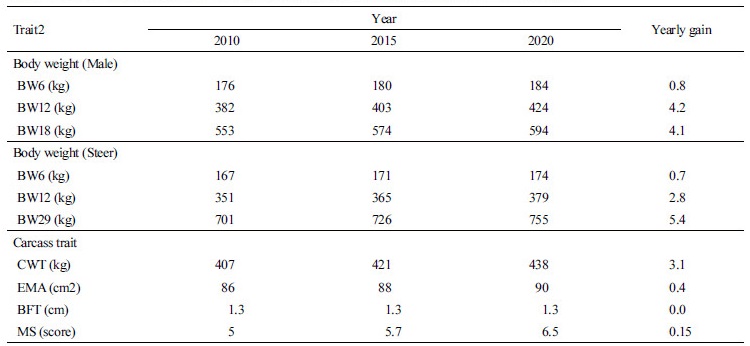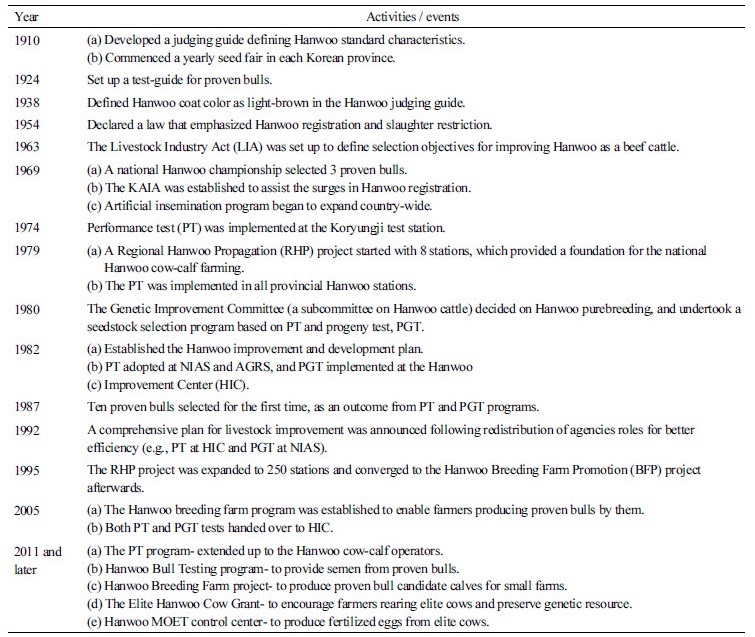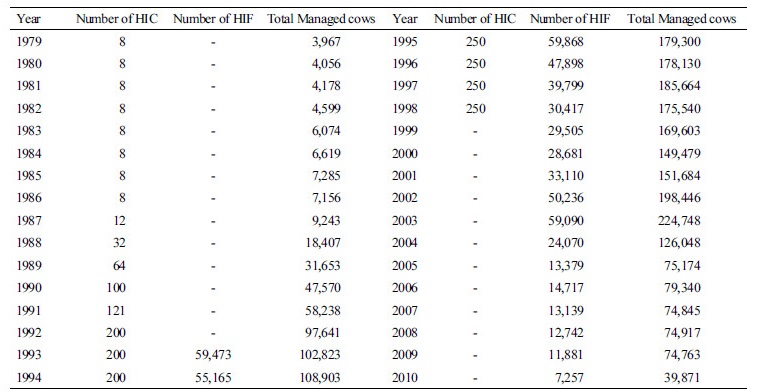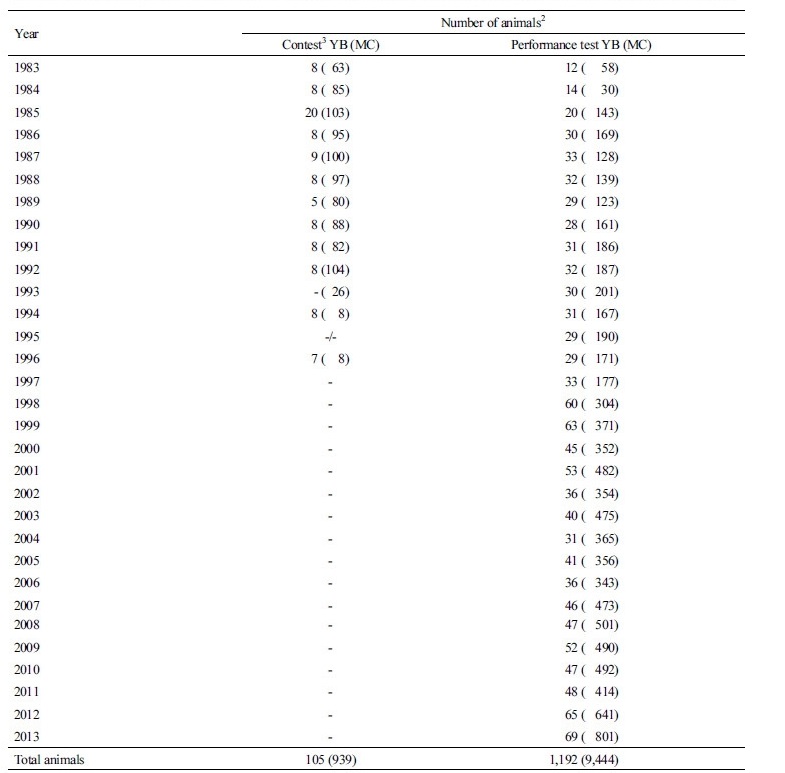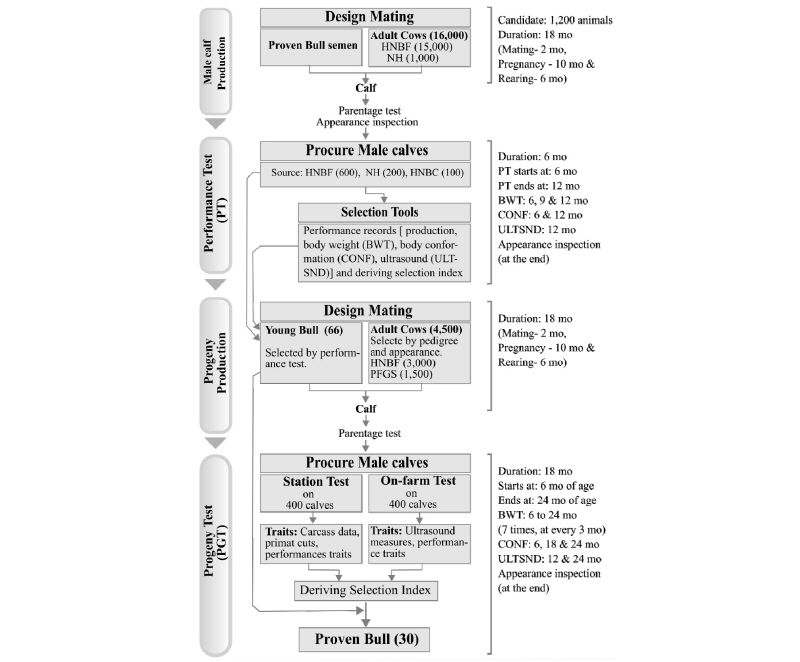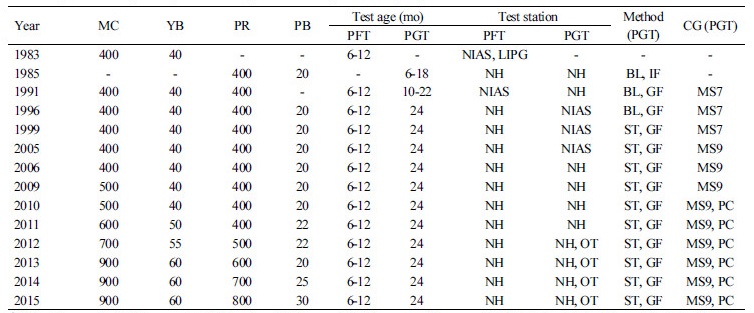Introduction
The Hanwoo cattle (Korean Brown cattle) is the most appreciated cattle breed in the Korean peninsula, that reportedly had served the local farming system since 502 A.D. (Kong, 2000). But, it dates back not so long ago when these cattle were first treated as potential genetic resources. It was in the 20th century, between 1910 and 1945, when Japanese animal breeders working under the colonial Japanese regime first began to realize the possible genetic worth of this cattle. Their subsequent and substantial interests had led to the development of comparative appraisal on cattle breeds, where these Korean cattle were compared with their local breeds for production performances. Afterwards, Korean local breeders also implemented many strategic breeding schemes, development initiatives, and conducted many researches about their genetic improvements, so that Hanwoo cattle could be established as the major contributor in the local beef industry. Since 1960s, with various genetic development initiatives in place, these cattle had shown significant improvement in meat quality for which they gained popularity in recent days as one of the leading marbled beef producer in the world.
About Hanwoo improvement, substantial evidence is found regarding various attempts for the strategic and practical implementations of breeding systems and development goals, aiming at either locally or nationwide since 1960s. Several breeding schemes and policies were either adopted or revised to boast the animal performances. Given all improvement initiatives, the problems and challenges arising from such efforts were neither negligible. Despite decades of initiatives from both government agencies and commercial sectors, to achieve greater profits from Hanwoo farming, some critical issues such as maintenance of inbreeding level, conservation of genetic diversity or appropriateness of breeding methods were found to be somewhat ignored. Our thorough investigation clearly revealed a severe lack of resources about one crucial aspect in the breeding system i.e., a comprehensive reference on decades of animal breeding activities, which is essential for the development of any reliable and sustainable breeding system.
However, it is an established concept that any sustainable development in the field of animal breeding is greatly entangled with the prior knowledge on the target animal population. Although, with the advent of genomic selection technologies, following the proposed genomic selection by Meuwissen et al. (2001), the traditional methods for animal improvements (the design of breeding) may appear to be as a forgotten discipline in Animal Science, its indispensable role for any long-run breeding improvement scheme is yet undeniable. Because, the knowledge on present and past breeding systems not only provides better insights into the past genetic architecture and gene introgressions in that animal population, but assists in formulation of more effective and well-informed breeding plans as well.
Conversely, it may not be surprising if future studies tend to interpret their outcomes on Hanwoo differently, simply due to the lack of proper evidence from their past genetics history. Therefore, the slower development of Hanwoo could be unavoidable in future. In this review study, we have attempted to provide a compendium regarding concise overviews on the Hanwoo population, their genetic diversity challenges, and listings of all major Hanwoo breeding improvement initiatives that have been implemented for decades. Our review partially included a brief on the workforces, agencies and organizations as well, that actively contributed to the progress of this breed to date. This study primarily aimed at the enhancement of understanding in the present and past Hanwoo cattle breeding systems, so that the formulation of future breeding initiatives could become more effective.
Status of genetic diversity in Hanwoo and its population structure
Genetic diversity
Despite tremendous efforts for the improvement in production performances of Hanwoo cattle, their genetic diversity issues remained somewhat unattended over decades. In accordance of the policies implemented towards its genetic conservation, some scholars argued upon some of the stringent strategies and stated that there had been a substantial decline in their genetic diversity over the past decades. They further asserted for immediate measures in this manner. Our investigation regarding their statement also revealed some interesting facts. It is found that such losses in genetic diversity could have been initiated by an adoption of regulation in 1938 when the development of brown-coated Hanwoo cattle was prioritized despite existences of other coat colors. This diversity decay was assumed to be continuing for several more decades as further follow- up policies were deemed to be insufficient regarding their extinction threats. One such policy was to register Hanwoo cattle in the “National Herdbook” based on an “Appearance Inspection Guideline” that could allow animals with four coat colors (brown, brindle, black and Jeju black; see photographic details in Lee et al., 2014) only. Another law that allowed the use of brown-coated cattle only as an “Official Seed Stock” whereas discarding other coat color types completely further intensified genetic diversity crisis. Nonetheless, those other coat color variants had received least attention for conservation to date.
More evidence strongly suggests that those of Hanwoo cattle other than the brown coat-type practically contributed none to the development of the present breed, except that they merely served as a criterion for distinction from all imported meat sources. Even to date, they are only permitted for an interim registration to the designated agency. The conservative proven bull semen production policy, as being implemented currently, also disqualifies many genetically superior bulls that possesses any sort of black blemish spots on their nose, a few white or black hairs around the mouth, ear or in their body regions. All these circumstances might cumulatively support to such existing threats in the genetic diversity of Hanwoo cattle, as suspected by many scholars already.
Population structure of Hanwoo
The distribution of Hanwoo cattle is mostly confined to the Korean peninsula. Although their natural habitat is widespread in this region, two major southern provinces in Korea such as Gyeongbuk and Jeonnam are most abundant for these cattle where, geographically, these regions are generally classified as low land or less mountainous (the west coast, south and south-east coasts) areas. Regarding their population size an approximate 2.67 million of Hanwoo cattle were recorded in 2014 (Table 1). The recent statistics also suggested a somewhat steady and noticeable leap in the Hanwoo population by 1.4 million cattle during the last decade (KOSTAT, 2015). However, our further investigation revealed some external factors that might have influenced their population size in the recent past. Such a factor could be listed as the farmers’ preemptive tactic to avoid economic losses before an assumed economic crisis or market slumps, resulting a marked increase in untimely bull sells for slaughter and a sudden decline in their population size. One of such unanticipated cattle sells rise (by 3 million) was recorded in 2012.
Table 1. Number of Hanwoo cattle by sex, age and year

|
|
*Source: http://kostat.go.kr (last accessed Nov. 2015) |
As it appeared, we found it worth noting about the characteristic composition of the recent Hanwoo population. Table 1 provides evidence of Hanwoo female population, especially 2 yr old and above, declining gradually over the last decade. Through investigations, we found that this change could have strong association with some of the government interventions, especially about the central authority’s role to control their growth. For this reason, the proportional increase in commercial male rearing (Table 1) was rather expected. Farmers showed more inclines to steer rearing over time. Recent statistics are in support of this farming trend, as a notable proportion of males (93.7%) raised in farms are now being steers (KOSTAT, 2015). As of raising males, Hanwoo farmers often showed higher tendencies in raising them for some extended periods which could also explain the proportional increase in older males (Table 1). Some authors (Kim et al., 2010; Alam et al., 2013) suggest that this extended raising period could finally benefit those farmers with higher beef grades.
Hanwoo farming trend and its impact on farming system
Hanwoo farms could generally be grouped into four categories based on their production scales (Table 2). In this study, we referred those farms as type A (1 to 19 cattle), type B (20 to 49 cattle), type C (50 to 99 cattle), and type D (100 cattle and more). Since 1985, the changes in total number of farms in each category, as shown in Table 2, has indicated a noticeable transformation in the Hanwoo farming system. The type A farms, once representing ∼99.5% of all farms in this region had reduced by 15 folds since 1985. At the same time, a greater number of medium to large scale farms (type B, C & D) were established. Table 2 also indicated that the total number of type B, C or D farms were 5 to 28 folds greater than those of the established farms in 1985. As statistics suggest, farmers might eventually be more inclined to type D instead of type A, B or C farming.
Table 2. Trends in growth of small, medium and large type Hanwoo farms

|
|
*Values in each cell indicate total number of animal per farm/herd; Type A (small), Type B (medium), Type C and D (large) |
It is obvious that changes in farming trends is inseparable from the economic status of farmers who are involved with the production system. Arguably, the recent statistics on “Livestock Production Cost Survey” might suggest that many large-scale farms gained more relative profits than those of the small-scale farms (Table 3) as relatively larger herds were more likely to lower the average production costs and could survive easily even at severe economic crisis. The noticeable reduction in the small farms might also provide clues for the substantial number of small scale farmers who were being forced to quit Hanwoo farming to circumvent financial losses; whereas the rest of the small farmers were converted into other larger farm types. Besides that, a severe disruption was observed in the supply of most fundamental input (i.e. calves) for the large farms (Lee, 2015). Nowadays, local livestock markets are facing greater challenges in supplying adequate number of calves to the larger-scale farms, according to Lee (2015); where the total calf purchases by larger farms were declined from 65% to 35% since 2000. The changes in farming trends from small to large scale could mostly be responsible for such declined calf production because most small-scale farms were main source of cow-calf production. We found that medium and large-scale farmers, however, were primarily involved in feedlot and composite (feedlots with cow-calf) productions, respectively. The 2012 farming records showed that the proportion of cow-calf, feedlot, and composite farms were only 45%, 5%, and 50%, respectively (Lee, 2014). Following such a noticeable decline in small farm numbers (from 99.5% to 45%), a deficiency in the supply of calves was rather inevitable. Nonetheless, the mutual benefit sharing among these farms were adversely hindered throughout these years.
Major agencies and their roles in Hanwoo Improvement
Since past few decades, the formulation, coordination and implementation of animal recordings systems, livestock development policies, and effective breeding strategies in this region were made possible through active contribution of various designated agencies (government and non-government) and research organizations. In the following subsections, we intend to provide a brief introduction to each of these agencies and their primary functions in the development of Hanwoo cattle.
The Ministry of Agriculture and Forestry
The Ministry of Agriculture and Forestry (MAF), Republic of Korea, also referred to as the Livestock Policy Bureau, is the foremost authoritative agency in the development of local livestock. The MAF usually develops policies and programs to promote the livestock productivity and competitiveness according to the “Livestock Industry Act, Article 5– Establishment of Goals of Improvement (LIA-5)”. Other important responsibilities it holds are providing support for breeding stock development and subsidizing necessary expenses for implementation of livestock projects. In 2015, MAF disbursed an approximated 46 million US dollars for conducting various animal breeding programs.
Its other roles include the execution of livestock improvement goals (Table 4), providing guidelines and procedures for performance and progeny testing. It also designates other agencies related to small or large-scale animal breeding programs, and then monitors their activities. This agency provides sizable revenues to the government treasury (about 20 million US dollars per year) as earned by selling of cattle semen.
National Institute of Animal Science
The National Institute of Animal Science (NIAS) is a government directed autonomous organization of Rural Development Administration. This is a designated agency by MAF that primarily coordinates with many other registered institutions for animal breeding programs. Besides an overall monitoring of various animal breeding programs, its responsibility further extends to the execution of national animal genetic evaluation through scopes created by the LIA-5 act. As one of the leading logistic support provider for MAF, NIAS was actively involved with the development of various animal breeding policies and programs such as the “National Livestock Breeding Objectives”. The Hanwoo Nucleus Breeding Farm (HNBF) program and Progressive Farmers’ Group Support (PFGS) program also receive direct contributions from NIAS.
As an advisory body, NIAS operates and recommends the “Committee for National Livestock Improvements” alongside its direct contributions to the animal breeding schemes, proven bull selection program, and other related agenda. Currently, there are five sub-committees working with NIAS regarding different animals (Hanwoo cattle, dairy cattle, swine, poultry and horse). Each of these sub-committees consists of 11 expert members from different fields i.e., university scholars, expert agency scientists, and farmers’ association executives. Likewise, the Hanwoo National Genetic Evaluation (NGE) program was started by NIAS in 1995. This institute also has started publishing “The Hanwoo Mating Guidebook” biannually since 2007, as an extension service in support of the NGE program.
Hanwoo Improvement Center
The Hanwoo Improvement Center, a research division under the National Agricultural Cooperatives’ Federation (NACF), is also recognized by MAF through the similar directives of LIA-5 as an active partner in the Hanwoo improvement programs. The key responsibilities held to the improvement center are to conduct the performance and progeny test programs, supervising HNBF and PFGS programs as well as Hanwoo semen production and distribution to the farmers. However, the fund for operating this center’s activities is managed from two sources mainly, where MAF subsidizes all expenses for Hanwoo breeding programs, and NACF finances the center personnel’s annual compensations. This agency also returns all profits to the government treasury which it earns by selling of Hanwoo proven bull semen. As our investigation proceeded further it became clearer that the inclusion of NACF in the breeding programs was probably not for profit gain but the fulfillment of an obligation from farmer’s cooperatives.
Korea Animal Improvement Association
The Korea Animal Improvement Association (KAIA) has been involved with various Hanwoo improvement programs since its establishment in 1969. This agency directly conducts the Hanwoo cattle registration program and participates in the animal improvement programs under the amendment of article 5 and 6 of LIA. The role of this agency extends up to most other local livestock species with an exception of horse. For Hanwoo, KAIA provides important services like herd-book information, animal registration, implementation of appearance inspection methodology (irrespective of sex), and the linear type appraisal for cows. The agency provides consulting services under the PFGS program as well. This agency has greatly contributed in the overall development of Korean beef industry to date.
Korea Institute for Animal Products Quality Evaluation
Under the LIA-5 act, MAF also identifies the Korea Institute for Animal Products Quality Evaluation (KAPE) as an animal improvement institution. One of the major responsibilities of KAPE is the evaluation of Hanwoo beef quality. Monitoring market standards for meat quality also resides under its jurisdiction. Further, KAPE reports the official annual statistics for carcass grading and publishes “Animal Products Grading Statistical yearbook”. Nonetheless, they also maintain the national carcass grading database, livestock identification database, and traceability database for public use.
Major Hanwoo improvement initiatives
The contribution of Hanwoo cattle was notable (22% to 42%) in the domestic agricultural production over the past 30 years, as various Hanwoo development strategies were undertaken to mitigate increased meat demands. During the 1970s, most of such strategies were focused on the genetic improvement of body weight due to farmers’ greater interests. In this regard, the foremost strategies were to improve through pure breeding and crossbreeding, simultaneously. After some initiatives from MAF, the crossbreeding strategy was abandoned due to a few reasons. First, the meat quality obtained from the crossbred animals did not supersede the imported beef quality. Second, it also deemed inefficient to reduce production costs through crossbreeding. Consequently, the pure breeding policy was adopted nation-wide with specific focuses on the qualitative and quantitative improvement for meats. This greatly served the conservation of local genetic resources as well. To promote the pure-breeding policy, the establishment of cow-calf farms was one of the prior initiatives. Some follow-up initiatives were performance and progeny test programs to improve the rate of body growth alongside their meat qualities. The nucleus farm program was commenced afterwards to ensure greater efficiency in the earlier programs. The urges for better marbling grades, for which Hanwoo cattle is much appreciated today, were in fact a much later development. The Uruguay Round Agreements in 1994 where the Korean beef market was decided to be opened for foreign meats also enforced Hanwoo cattle development as greater competitions were evident. Nowadays, there is a full-fledged meat quality monitoring and evaluation system in place to ensure better local meat production, imported meat quality and consumer satisfactions. Table 5 presents a summary on improvement initiatives as recorded since 1910 based on reports by Park et al. (2013).
The following subsections provided a brief overview of the major strategies regarding the breeding program, animal production, and market development which influenced the Hanwoo improvement for decades.
The Hanwoo improvement complex program
In 1979, MAF first launched a program name “Hanwoo Improvement Complex (HIC)”, locally known as “Hanwoo Gaeryang Danji” (in Romanized Korean) to promote the purebred Hanwoo cow-calf farm production. To do this, MAF identified several groups of cow-calf farms as HICs in several selected regions and managed them under direct supervision of “National Livestock Cooperatives’ Federation”, an organization that merged later with NACF in 1998. Some financial supports to all HICs were also provided. Although the cooperatives’ federation was entitled to overall management and monitoring of HICs, its field-level operational responsibility was on the local livestock cooperatives (LLC). The HIC program remained operational until 1998. This program had greatly facilitated those HIC farms to increase in number i.e., from 8 to 250 between 1979 and 1995 (Table 6). During the operational period, all HIC farms supplied a substantial number of dams to produce young bulls and progeny test male calves. However, there was a growing concern about the success of HICs as there was no measure to disqualify a poorly operated HIC farm.
The Hanwoo improvement farm program
With the emergence of undesired HICs, their dismissal became a crucial challenge. The “Hanwoo Improvement Farm (HIF)” program or “Hanwoo Gaeryang Nongga (in Romanized Korean)” was initiated in 1993 to resolve this crisis (Table 6). In principal, the HIF greatly resembled the previous HIC program. However, its main distinction from the HIC was that it evaluated each cow-calf farm performance separately rather than a group of farms together. MAF also discontinued supports to the poorly functioned HIFs. After a successful pilot experiment with HIF program for 5 years, it was replaced with the HIC program and remained operational until 2009. Agreed upon the fact that neither of HIC or HIF programs were flawless during their execution, the cows that they produced served great roles as dams of the young bulls or progeny test male calves, even though their lack in pedigree depths (<3 generations only).
Hanwoo proven bull selection program
The Hanwoo proven bull selection was consisted of two sub-programs such as the performance test (PT) and the progeny test (PGT). These sub-programs were introduced in 1983 and 1985, respectively. At the beginning, young bulls required for these programs were selected from the performance tested calves and selected bulls via the Hanwoo Champion Contest. The contest was held routinely between 1969 and 1996. From 1997 and onwards, young bull selection was performed on the pool of performance tested calves only. Record from 1983 showed that among the total of 121 performance tested males, 20 selected young bulls were either performance tested between 6–12 mo of age or HCC (Table 7). In contrast, the number of performance tested male calves increased steadily to 371 males by 1999, fulfilling about 93% of the target (400) as planned. In 2009, MAF also proposed a revised target for gradual acquisition of 800 PT and 900 PGT young calves. With an expected greater availability of calves by the target period, the selection of 60 more young bulls and 30 more proven bulls were also planned. Between 2010 and 2013, the incremented total PT bull selections were planned as 40, 50, 55, and 60. In 2017, a total of 66 young bulls were selected in PT phase. For PGT, the target for selecting proven bulls were set to 20 (2010), 22 (2011), and 20 (2013). Since 2014, 30 proven bulls per year were selected from the PGT program. An average of 9 progenies per young bull and a ratio of 0.57 in proven bull to young bull selection were obtained finally, as our investigation revealed. We discussed both PT and PGT programs elaborately in later sections as well.
Hanwoo nucleus breeding farm program
Both HIC and HIF programs were somewhat unable to properly support the Hanwoo proven bull program. Both HIC and HIF had supplied candidate male calves to the proven bull program. In the early 2000s, it was noticed that not only less than 4,000 cows from those programs were used for male calf production, but also different cows were always used in each batch of PT and PGT. The absence of seasonal breeding in HIC or HIF farms was one of the many reasons. Another important reason was the existing very short mating-window (2 mo/batch) for producing candidate young bulls or progeny testing calves. Consequently, only a smaller fraction of the total cows was used for mating, and this created a very little chance to the same cow being used further to properly account their permanent environment influences on the proven bulls. In other words, there was neither selection on dams of sires nor a truly design mating for the young bull-calf production. Those programs also put less consideration on cow’s own performance except for pedigrees and appearance inspections. A new amendment imposed by MAF in 2004 thus enabled the redesigning of candidate young-bull production structure with a certain number of cow-calf farms. This has created chances for all animals to be recorded for their own performances and to be well-managed in many aspects such as seasonal reproduction, record keeping, designed mating or animal disease control measures etc.
Following the 2004 amendment, the new HNBF program or “Hanwoo Yookjong Nongga (in Romanized Korean)” was started in 2005. The farms enrolled under HNBF were considered as nucleus farms under the Hanwoo breeding scheme. Even though a total of 11 farms were selected initially for HNBF, a selection target of 40 farms by 2008 was set to bring 4,000 cows under the program. Later, as this program continued further, a revised target of selecting 100 farms with 10,000 cows by the end of 2014 was included into the schema to attain higher selection intensity for the young bulls. Effectively enough the target was achieved and a total of 104 farms (100 private and 4 provincial governments institutes; 18,000 registered cows) were selected as HNBF (Table 8).
Table 8. Number of breeding farms enrolled in HNBF by years
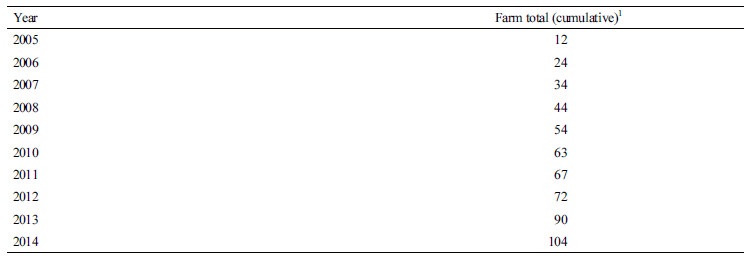
|
|
1Total farm count excluded all disqualified farms. Four institutes operated by provincial governments were included |
These breeding farms were obligated to perform several tasks such as weighing animals at 3 mo interval, following designed mating programs for cows, practicing a seasonal reproduction, parentage testing, periodic disease test for all animals, submitting male calves to NACF for performance testing, and participating annual education. The HNBF status of a farm was revoked if it failed to perform these mandatory tasks, followed by the subsequent withdrawal of all facilities provided by MAF unless the cause of failure was inevitable accidents or disasters. If vacant positions were created after such status revocations at a given time, those opened positions were filled with newly selected farms. Each farm enrolled as HNBF was encouraged through several services. The list of services includes mating design with genetic evaluation for each of the individual, DNA parentage test, periodic disease surveillance fee, weighing scale, semi squeeze shoot for performance testing etc. Additionally, a calf producer was awarded by $10,000 (for young bull) and $50,000 (for proven bull) for each of the calf selected in a year, irrespective of the purpose of selection. However, a few of the HNBF farms were enrolled as the designated progeny test farms.
Progressive farmers’ group support program
In 2010, following the end of HIF program, MAF started this (PFGS) program aiming to support group of farmers who were interested to improve their cows or animals through personal investment. PFGS program was considered as a replacement for HIF. Unlike all preceding programs, this program was designed quite differently. Firstly, each farmer enrolled in this group support program had to pay a definite amount of cost for services received (ultrasound measurements, animal registrations, and animal breeding consulting services) to obtain the financial support from MAF in return, whereas some services rendered to HIFs were free of charges alongside the subsidies they had received from MAF. Secondly, as a distinctive advantage over those of HIFs, every PFGS farmer received various consulting services i.e., setting up breeding objectives, genetic evaluations, and mating design. The HIF farmers, on the other hand, only received animal registration service without those vital consultation services.
With MAF’s support, farmers’ groups could access various animal breeding consulting services at lower expenses. Note that the eleven consulting institutions representing national universities, organizations or institutes were authorized by NIAS to assist in this program. Standardizing basic consulting services for authorized institutions is another responsibility for NIAS. As a result, each of the consulting experts could produce homogenous outcome in accordance with the responsibilities issued to provide by each. Farmers also received certain level of services regardless of the service providers sought. Nonetheless, launching of those consulting services benefited both farmers (with an easier access of animal breeding services) and university professionals (with more research fund opportunities). Reports showed that a total of 55 groups (10,298 farms with about 202,000 cows) were enrolled in this program in 2013 only.
Major Ongoing Programs for Hanwoo Cattle Improvement
Currently, a few large-scale Hanwoo cattle improvement programs are being implemented in Korea. That include both breeding, production, distribution and additional assisting programs. Although a glimpse on few of those programs is provided already, the following sub-sections detailed a more concise review on each of those programs for more comprehensive understanding.
Hanwoo proven bull selection program
Objectives and implemented techniques
The PBS program was established to produce semen from superior sires and disseminate it to HIF, HNBF, and HIC farmers as an assistance to those programs. Basically, PT and PGT programs under this scheme were entitled to be executed as tier-1 and tier-2 phase, respectively. The first implementation of tier-1 or PT was in 1983. The tier-2 phase (PGT) was followed in 1985 when crops from the PT program were available. Animals were not tested for parentage at the beginning. In 1991, the parentage test was included with the program. Parentage test was performed by blood serum protein typing through which accurate animal parentages were determined. This blood serum based parentage testing was replaced in 2007 by microsatellite marker (MS marker) based method for more accurate prediction of animal parentages. In 2010, an ultrasound measurement system was adopted in tier-2 through assistance from Iowa State University, USA. Table 9 shows a summary on animal selection through PBS program since 1987 to 2013.
Table 9. A summary on young male testing, progeny production and proven bull selection under progeny test program by years1
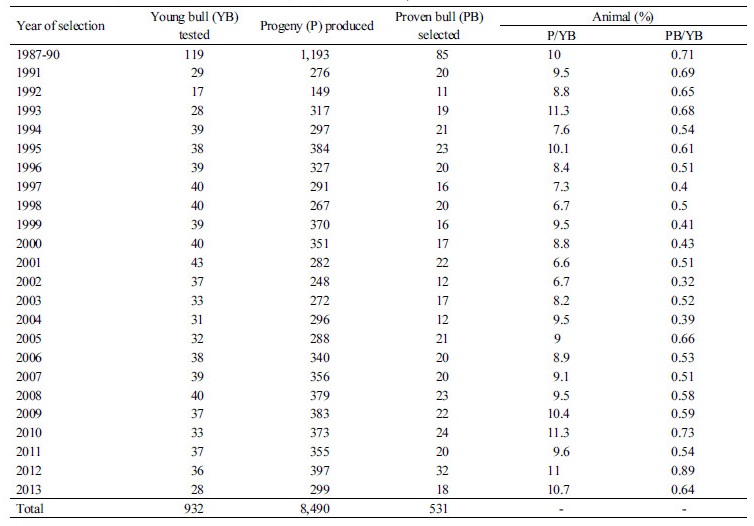
|
Agencies involvement
Various agencies were involved in the execution of PBS scheme since its initiation. At first, NIAS and LIPG (livestock institutes under provincial governments) were authorized for PT program, whereas HIC was assigned to PGT program (Table 10). After PBS remained operational for a decade, performances of all agencies were reviewed in 1996 and their roles were reassigned for next 10 years (up to 2005). This reassigned the roles of NIAS (from PT to PGT), and HIC or NACF (from PGT to PT).
That slight alteration in activities, as we observed, was a necessity because of the failure of LIPG to deliver sufficient male calves and young bulls from PT program. It is worth noting that each LIPG which produced male calves only, as per MAF guidelines, was accountable to conduct performance testing on them as well. After 2005, all the stations operating PT and PGT schemes were converged to NACF stations, as an attempt to minimize environmental influences on tested animals.
Major phases
Although, the whole scheme runs in 2 tiers, allowing to choose proven bulls at each 5-year window, the entire program includes some additional smaller phases (Figure 3). An average 18 mo of production phase that precede tier-1 is defined as the “male calf production phase”. This pre-PT phase is conducted in various HIC, HIF, HNBF, PFGS and HIC farms. As tier-1 phase progresses to 6 mo, a “progeny production phase” is continued for another 18 months until tier-2 phase is performed. The tier-2 phase further adds a period of 18 mo to the PBS cycle. Following the completion of tier-2, both “genomic evaluation” and “semen production” programs are executed, respectively. As soon as a proven bull is selected finally, it requires a lowest window of 2 months for that bull to produce adequate frozen semen for commercial distribution. A PBS cycle is completed with 2 mo periods of semen production.
Modes of operation
In tier-1 phase, the performance tests of young bulls are generally performed between 6 and 12 mo of age (Figure 3). Young calves to be used in this phase are produced in the earlier “calf production phase” through the designed mating. While the parentage test and appearance examinations are completed, the candidate young bull calves (N = 900) are purchased from farmers (HICs, HIFs or HNBFs) at a 30% higher rate than the market price. During tier-1 phase, these young animals are recorded for several traits related to production, body conformation, and ultrasound traits i.e., body weight, body length, chest depth, chest width, chest girth, wither height, hip height, rump width, rump length, pelvic width, hipbone width, loin eye intramuscular fat percent, loin eye area, and rump fat thickness. Within 1 yr age of calf, multiple records are taken at different intervals for body weights (6, 9 and 12 mo) and body conformation (6 and 12 mo). However, live ultrasound measurements are performed at 12 mo of age only. An appearance inspection is also performed at the end of PT.
During performance testing, young bull genetic merit is calculated using an index IYB = 2BVYW + BVMS, where BVYW and BVMS are standardized estimated breeding values for yearling weight and marbling scores (parents average), respectively. On the other hand, their mating candidates (cows) are selected from HNBF or PFGS farms based on their pedigree and appearances only as cow performance records are seldom maintained in those farms.
Conversely, as in tier-2 phase, the progeny test program is set to start at 6 mo and end at 24 mo of age. After parentage testing, male calves are procured from the farms (HIC, HIF or PFGS) using similar purchase rates as applied to the PT calves in tier-1 phase. However, the appearance inspection is not applied in the progeny test program. Although, cows’ appearances are inspected at mating time so that sources of defects (cow or sire) could be traced back easily. All steers in the PGT are measured 7 times for body weight between 6 and 24 mo at each 3-month interval. For a similar set of body conformation traits as in tier-1, animals are recorded at 12, 18, and 24 mo of age, respectively. Unlike tier-1, ultrasound measurements are performed twice in this tier, both at 12 and 24 mo of age. Finally, records collected at the end of progeny test phase include carcass data (carcass weight, eye muscle area, backfat thickness, marbling score, meat color, fat color, texture, maturity, yield grade, quality grade, meat yield index, and final grade) and major primal-cut yields (chuck, shoulder, brisket and flank, ribs, tenderloin, striploin, sirloin, top round, round, fore and hind shins). Additionally, some basic chemical compositions on meat are determined from the striploin region, which undergoes some verification before being used. Since 2017 onwards, an index that has been proposed to select proven bulls in tier-2 is IPB = BVCWT+ BVEMA − BVBFT + 6×BVMS, where IPB is the proven-bull index, and BVCWT, BVEMA, BVBFT and BVMS are standardized EBV estimates for carcass weight, eye muscle area, backfat thickness, and marbling score, respectively. Note that previously this index did not consider breeding value estimates for carcass weight only. The tier-2 phase, so thus PGT is concluded with an appearance inspection of animals.
Selection target on young candidate bulls
The target for total proven bull selection was revised over the years. Until 2008, a total of 400 male candidates per year were brought to HIC for PT program and about 10% of them were selected as young bulls. In 2009, MAF set a target for performance testing of 900 male calves per year by the end of 2013, through a gradual increment from 400 calves. Although, only 873 calves were performance tested by 2013. It is, however, expected that the target could be reached in 2017. In 2012, a similar revised target was set for PGT program (from 400 to 800), following a gradual increase in test animals up to the target. This included on-farm tests as well. Data showed that the selected proportion of young bulls to the male calves was about 7.3% (66/900) and that of proven bull was 45% (30/66) in 2017. This reduction in selection ratio in PT program, from 10 to 7.3%, will have definite impact on the selection intensity (about 10%) of animals.
Problems and prospects
It is obvious that the implementation of PBS provided stabilities in other on-going programs and established designed mating system in Korea. This also greatly benefited the adoption of country-wide artificial insemination. Contrarily, there remains some unsolved issues in its core sub-programs (station and on-farm) that essentially raise concerns for its efficacy. First such an issue is the difficulty in combining both sub-programs phenotypic observations together because each finish at a different time. More precisely, the station and on-farm tests have production cycles of 24 and 29 mo, respectively. Therefore, the station tested animals are slaughtered 5 mo earlier than the on-farm tested animals and it is almost impossible to obtain post-mortem carcass measures at the same time across programs. As for alternatives, carcass ultrasound measures are practiced in on-farm test case scenario. With a 65% accuracy from ultrasound techniques, as a contrary to the actual measures from station-tests, the second concern arises because it is easily realized that some degree of inaccuracy is introduced in each cycle of proven bull selection process. With two stage selection schemes, overall performances (genetic gain) from the PBS might be of some concern and thus held challenging, especially if traits (yearling weight, loin EMA and MS) show antagonistic relations. In such case, a selection index optimization in both programs are essential which is yet to be implemented.
Scopes for future extension
The current PBS scheme is limited to a few traits and ignores many important traits such as feed intake, fertility, and calving ease traits. Inclusion of these traits could be time demanding and challenging, given the complexity of the program co-ordination between agencies and farmers. Recently, the feasibility test for feed intake trait is ongoing at NACF. However, our investigation suggested no near prospect with reproduction traits (for farm data collection) avails yet.
National genetic evaluation of Hanwoo cattle
Objectives and implemented techniques
The development of this program was aimed to determine genetic merits of animals that were reared under the breeding programs. It helped to set selection criteria for animals under those programs too. But, it was also the farmer (HIC, HIF, HBNF, or PFGS) who was in needed of choosing the appropriate proven bulls as best mating partners for their cows. It was also necessary that farmers could have proper breeding tools at their disposal for avoiding inbreeding depression as much as possible. Also, the deployment of NGE in 1995 had replaced the earlier implemented least squares model to Henderson’s mixed model (also known as Best Linear Unbiased Prediction, BLUP; Henderson, 1973) equation for evaluation of phenotypes from young bull and progeny tested bulls. BLUP model with single trait evaluation was performed for more than a decade after NGE was initiated. Since 2009, the old evaluation model was converted to multiple traits evaluation (with similar BLUP model architecture) so that an improved accuracy could be obtained. The NGE program included regular publication and distribution of the “Hanwoo Mating Guidebook” since 2007. In each edition, the guidebook provides the revised animal genetic merits from the NGE program and the pedigree indices of the cows. The pedigree index is calculated from the sire EBV of a cow and that of EBVs of other proven bulls.
Agencies involvement
The NACF was in charge for execution of NGE program between 1983 and 1994. This responsibility was later reassigned to NIAS and it remains responsible for this program to date.
Modes of operation
Animals under the genetic evaluation mostly include those selected for the PT (young bull) or PGT (proven bull) program. Traits recorded in animals are yearling weight and carcass traits (CWT, EMA, BFT, and MS) to evaluate using multiple traits model. For single trait animal model, as used in the PBS, body conformation traits are only recorded at 18 months of age. Mainly two contemporary group factors are considered in each evaluation with respect to model variations. Two combined fixed effect of batch, birth location, test station (BLT) and batch, test station, slaughter day effect (BTS) are used. The difference between steer and bull performances is considered by the as interaction of batch and test station is completely confounded with sex. Data analyses for the genetic evaluations are performed using computer software packages such as SAS 9.2 software package (SAS Institute Inc. 2008) and BLUPF90 family programs (Misztal et al., 2002).
In both tiers of PBS, the estimation of variance components is carried out through multiple trait animal model which is Y= Xb + Zu + e, where Y is the vector of traits (yearling weight, carcass traits etc.), X is the incidence matrix related to fixed effects (BLT and BTS), Z is the incidence matrix related to animals and u is the random animal genetic effect, and e is the vector of random error terms. In multiple traits model, YWT is fitted with BLT in both PT & PGT programs whereas, carcass traits are fitted with BTS only in the PGT program. However, the single trait animal model analysis for each of the body conformation trait included fixed effect of BLT and a covariate effect of age at test day.
A summary on genetic parameters
The heritability and genetic correlations for yearling weight and carcass traits are listed in Table 11. The estimates of heritabilities for body conformation traits are listed in Table 12. Figure 2 and 3 has shown the trends of estimated breeding value for yearling weight, carcass traits and body conformations. These estimates are useful in the prediction of animal performance for selection.
Table 12. Estimates of heritability for body measurement traits at 18 mo of age used for genetic evaluation
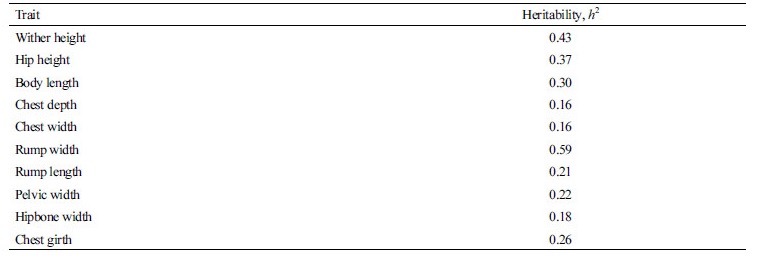
|
Problems and prospects
Due to the statistical advantages of multiple traits model as compared to a single trait analysis, the limitations associated to proper account of genetic correlations while deriving selection index was resolved easily. The accuracy of EBVs was also improved. However, there yet remained some issues regarding EBV accuracy, especially with the selected proven bulls. Our observation indicated that it might be due to the quality of EBVs that were being estimated mostly from station-based PT and PGT records. Most on-farm records (carcass traits) on progenies of proven bulls, therefore, remained unincorporated while deriving of proven bull EBVs. Another challenge was found while the extraction of data with correct pedigrees as slaughter houses could access only to national cattle identification (without pedigree) system. With these existing constrains, there is no alternative for parentage test or sire analysis before collection of carcass data for NGE.
Hanwoo semen production and dissemination system
Objectives
The main of objectives of this system are set to produce superior semen from selected proven bulls as well as to create an easier access to these genetic resources for the farmers of other breeding programs. This system was first initiated in 1987.
Annual semen production
Table 13 shows the production and distribution of semen straws of Hanwoo young bulls and proven bulls in the past decade. An average of 40,000 straws of frozen semen per proven bull in each year is produced within the existing semen production framework. Note that the target for total semen straws from each bull is rather arbitrary and it is revised regularly based on semen demands. Sometimes, regulations in total semen production are introduced to control inbreeding levels in the population. A proven bull could produce upto 120,000 straws until 2014. After that the production upper limit has reduced to 100,000.
Agency involvement for semen dissemination
The NACF produces and distributes frozen semen to the artificial insemination (AI) technicians or farmers. The LIA, Article 15 (Registration of Business for Processing Semen, etc.) authorizes no other organization but NACF for registered cattle semen production. The appointed NACF personnel (12) visit and distribute semen straws in their assigned towns in turn. An internet based selling service is introduced recently by NACF to ensure equal chances for procuring highly demand proven bull semen.
Semen pricing, demands and challenges
Before 1999, Hanwoo farmers were mostly less concerned for the proven bulls’ genetic superiority and semen prices were similar regardless of semen quality as a result. From 1999, semen price distinctions were introduced through classification of semen straws into 3 categories based on the proven bull selection index. This encouraged farmers to understand the importance of bull EBV differences and to make informed decisions for proper bull semen as per breeding goals. Although this strategy turned out to be a huge success, it also created great demands for some elite proven bulls. Consequently, NACF faced great challenges to mitigate such demands and to lower farmers concerns. The semen supply chain also deemed ineffective due to the government’s indirect regulation for semen price settlement.
Carcass grading system for cattle
Adoption, grading types and agency involved.
After a 3-yr test phase, the beef carcass grading system (BCGS) was finally established in 1992, following a nation-wide adoption by 1999. The adoption of BCGS was a crucial step forward to ensure meat quality as per consumer demands, reasonable meat pricing with respect to beef producers and consumers benefits. The BCGS consists of both meat quality grade (MQG) and meat yield grade (MYG). The MQG includes 5 categories (1++, 1+, 1, 2 and 3) to meat quality assessment, whereas, MYG considers 3 categories (A, B and C) to denote meat yield assessment. The KAPE, as described in section 4.5, was assigned for monitoring meat quality standards.
Modes of grading
Basically, according to BCGS, a quality grade is calculated on marbling score, meat color, fat color, firmness, texture of lean meat, and maturity. Although six factors are used for obtaining an MQG, marbling score (MS) always plays the major role to determine a carcass grade. Determination of MS is a subjective process and is performed by authorized technicians only following a beef marbling standard (BMS, Figure 4). The BMS are classified as MQG 1++ (MS 8 and 9), MQG 1+ (MS 6 and 7), MQG 1 (MS 4 and 5), MQG 2 (MS 2 and 3), and MQG 3 (MS 1). Therefore, a higher MS indicates a higher quality grade of the meat. The BMS scale was designed to attribute a 2% higher intramuscular fat (IMF) contents for each level rise of MS, where the lowest MS should contain IMF≤ 5%. Thus, MS 1 through 8 correspond to ≤ 5% and ≤ 19% IMF, whereas an MS 9 indicates IMF > 19% in beef. The Hanwoo beef that obtains a MQG 1++ or 1+ score is also categorized as a premium beef.
On the other hand, the meat yield grade is calculated as meat yield index, which is a function of several constants and some traits. The equation used for index is, MYI = 68.184 − 0.625 × BFT + 0.130 × EMA − 0.024 × CWT + BAF, where BFT is the backfat thickness in mm, EMA is the eye muscle area is cm2, CWT is the total cold carcass weight in kg, and BAF is the breed adjustment factor (3.23 for Hanwoo and 0 for other breeds). The MYIs of ≥ 67.5, ≥ 62.7 to < 67.5, and < 62.7 and correspond to MYG of A, B, and C, respectively.
Overall Discussions
Hanwoo improvement programs and roles of others (i.e. implementation agencies, farmers) in above mentioned programs had been revised and reassessed several times over decades to complement the Hanwoo development with set breeding objectives. Despite such efforts, some breeding improvement decisions particularly the maintenance of genetic resources appeared somewhat debatable to date. Although the demand for increasing total young bulls and reconsideration in the stringent appearance guidelines were echoed sometimes by many animal breeders, their demands were often disregarded. Yet the existing selection program discards superior proven bulls as the primary focus is on the preservation of Hanwoo genetic purity. The performance and progeny test programs were revised a few times such as increasing the number of tested animals, but lesser efforts were put for the optimization of two staged selection schemes. It is also necessary to maintain the proper selection ratio of young bulls to candidate bulls, and candidate bulls to proven bulls to improve accuracy in selected proven bulls. Our investigation revealed additional challenges regarding the availability of dams for progeny test program and a less opportunity for increasing young bulls until recently. An insufficient calf production in the farming system was also observed. We think that there should be increasing support for existing small-holder farms (calf producers) from government agencies so that they could survive at crisis period and be encouraged to continue their farming practice. However, some major progresses are expected in future as newer genetic technologies are being introduced in the production chain. For example, a genomic selection program is scheduled to be practiced in this year as a follow-up response to the earlier initiated study in 2015 on genomic selections in Hanwoo breeding scheme. The genomic EBV is planned to be used during the procurement of young bull candidates (male calves) from various farms by NACF and during the selection of young bulls. This genomic selection program will allow the use of carcass data collected across the country in greater extent, therefore assisting the ongoing Hanwoo performance and progeny test programs.
As for the argument of genetic purity versus genetic diversity, it is not unlikely that both sides in this debate have logical arguments on behalf of their respective claims. We found that some authorities related to Hanwoo improvement programs who firmly support the stringent appearance guidelines also argue on the point that any ease of criteria (nose speckles, black or white hairs on the body) would cause in potential genetic admixture. Contrarily, scholars in support of the notion of easing rigorous restrictions essentially prioritize the effective use of genetic merit of animals, with minor compromises in exact physical appearances. This is because genetic progresses are often slow in practice. Thus, an animal proved to be genetically superior is always at highest demand. From breeding and production viewpoints, the later approach is often more attractive as discarding such genetically superior animals, which are proved through a very expensive progeny test program, would be economically undesired. This could also slowdown future genetic progresses as discarding of many superior sires from the genetic pool of this breed might initiate depressions in overall progresses for many economic traits, due to significant loss of existing genetic variations. To compensate such genetic losses while pursuing breeding objectives would demand for more costly strategies such as selection of extensive number of animals each year to ensure target selection responses. Therefore, it would be worth considering those animals which show minor appearance imperfections unless that commence hindrance in breeding objectives for economic traits or initiates unexpected deleterious effects in the gene pool. However, it will certainly not be easy to choose between the demands for authenticity or faster genetic progress, as they implicate social or economic values. We, therefore, believe that finding an intermediate strategy, validated through genomic information and detailed genomic studies, is an imminent choice rather than a prolonged disregard of the increased demands for higher meat production and its market competitiveness with other breeds. Because a narrow gene pool could potentially slow the genetic progresses if continued for decades, therefore imposing undesired threats in future. On the other hand, the leading agencies such as NIAS and others should be given more authority for development of newer methods regarding breeding scheme optimization so that progresses in Hanwoo industry could move one step forward.
Conclusions
In this study, we outlined the present Hanwoo breeding system in a comprehensive manner for the first time. We focused on the roles of different agencies and others who are leading this industry and about their possible future contribution. This review also detailed some problems in the Hanwoo breeding and production system. Some concerns about Hanwoo genetic diversity was evident caused by the increased “between-animal” relationships. Thus, all future breeding programs should not only be designed for minimizing inbreeding rate but also for creating more scopes for other existing genetic variations to express phenotypically. Hanwoo population being geographically constrained and very little chances for genetic introgression from outside sources, as current breeding policy targets, it is important that newer technologies are used to incorporate all existing genetic variations in the population. From genetic perspective, it would be unrealistic and an irreversible loss if any desired genetic variation remains unused in such closed population. Revising animal breeding goals and animal testing programs are also prerequisites for more precise genetic merit predictions. Our hope is that some suggestions drawn in this review would assist greatly in the formulation of future Hanwoo development plans.


